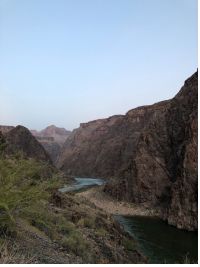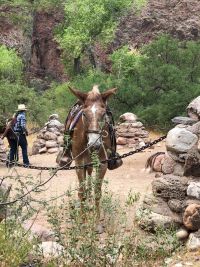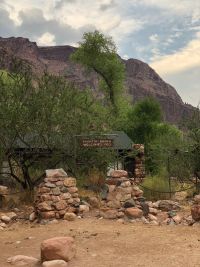Every year, Grand Canyon National Park attracts millions of tourists spanning the globe. Few choose to venture below the canyon rim, and even fewer attempt the park’s infamous Rim to Rim hike. If you’re here, you’re just beginning to plan and figure out what it takes to complete this challenging but incredibly rewarding traverse through one of the seven natural wonders of the world. Use this guide as a starting point to set yourself up for a successful Rim to Rim hike.
Rim to Rim at a Glance
Trail Location: Grand Canyon National Park, USA.
Trail Length: Grand Canyon’s Rim to Rim hike is approximately 21 to 24 miles long point-to-point, depending on your route. Starting from the North Kaibab trail at the North Rim, you can end your hike at the South Kaibab or Bright Angel Trailhead on the canyon’s South Rim.
Trail Difficulty: The Rim to Rim hike is considered extremely strenuous due to its length, steep grades, and demanding high desert terrain. Hikers should be in excellent physical condition and preferably have prior experience hiking at altitude and in desert climates. Rim to Rim is not recommended for novices or families.
Elevation Gain: Depending on your starting and ending points, you’ll gain anywhere between 5,000 and 6,000 feet from one rim to the other. Starting at the North Kaibab Trailhead and ending at the South Kaibab Trailhead starts with a drop of 5,800 feet, and a climb of 4,400 feet at the end. Reverse this for the South to North route.
Points of Interest: Rim to Rim offers breathtaking panoramic views of the Grand Canyon, giving hikers a front-row seat to the canyon’s storied geological evolution. Points of interest along the trail include Roaring Springs, Phantom Ranch, Bright Angel Creek, and the Colorado River itself.
Camping on the Trail: There are designated camping areas along the Rim to Rim trail, including Cottonwood, Bright Angel, and Havasupai Gardens Campground, along with lodging at Phantom Ranch, located near Bright Angel Campground. Camping permits are required and need to be obtained in advance through the Grand Canyon National Park Backcountry Information Center.
Water Availability: Water sources along the trail can be limited depending on the time of year and your route. Water is not available on South Kaibab Trail. Year-round water sources managed by the park include Havasupai Gardens Campground, Bright Angel Campground, and North Rim Backcountry Information Center. Seasonal and natural water sources do exist along the trail, but you need to check their availability ahead of your hike.
Weather Conditions: The Grand Canyon’s weather can be unpredictable, with extreme temperature variations between the rim and the bottom of the canyon. During the summer, temperatures at the bottom of the canyon regularly exceed 100 degrees, while winters bring icy conditions and snowfall along the rim.
Trail Accessibility: The Rim to Rim trail is not accessible year-round. The North Rim is usually closed from mid-October to mid-May due to snow. Careful planning, research, gear selection, and physical training are all essential for this hike.
How To Get a Permit for Rim to Rim

Gorgeous Canyon Views
The good news is, if you want to hike or run Rim to Rim in a single day, you don’t need a permit! Now, if you plan to make this a multi-day adventure by camping or lodging at Phantom Ranch, you’ll have to jump through a few hoops.
If you plan to camp:
If you want to camp anywhere in the park, other than in developed campgrounds on the North Rim or the South Rim, you must obtain a backcountry permit from the Backcountry Information Center either in person, by fax or by mail. Old school, we know.
In 2024, Grand Canyon National Park plans to move its overnight backcountry reservation system to Recreation.gov.
To learn the process of obtaining a permit for the 2023 and 2024 seasons, check out the park’s Backcountry Permit page.
If you plan to stay at Phantom Ranch:
Phantom Ranch is a historic oasis nestled at the bottom of the Grand Canyon and is the only lodging below the canyon rim. It can only be accessed by mule, on foot, or by rafting the Colorado River. If you’re hiking Rim to Rim, Phantom Ranch is a great halfway point to take a load off your feet, grab a snack and cold drink from their canteen, or spend the night in one of their air-conditioned cabins.
Due to the high demand for this unique experience, guests are required to enter a lottery to stay in one of the hiker cabins 13 months in advance. If your schedule is flexible though, you can snag a last-minute reservation on their general availability calendar throughout the year. Learn more about booking accommodations at Phantom Ranch here.
Do This Before Your Hike

Horses along the rim to rim
Decide how long it will take you to do the hike
The first thing you’ll need to figure out is how you want to hike the Rim to Rim trail – as a day hike or multi-day backpacking trip. This decision will impact your gear choices, when you hike, and shuttle or accommodation logistics.
Day hike: Rim to Rim can be done in one day if you start before sunrise and get through the hottest part of the canyon before 10 a.m. You’ll have to cover a lot of ground fairly quickly, depending on where you start. Keep in mind, the North Rim shuttle service operates from May through October, so you’ll have limited scheduling options.
Multi-day backpacking trip: Many hikers prefer to take their time traversing the canyon by making a multi-day trip out of their Rim to Rim experience. There are limited spaces in the campgrounds along the route, and the competition is fierce. Get your accommodations and campsites sorted, and make a backup plan in case you can’t get the sites you want. You’ll also need to book shuttle services at the end of your hike unless you plan to retrace your steps.
Decide what time of year you’ll hike
The best time of year to hike Rim to Rim is either early October or late May when temperatures are reasonable, and the North Rim is open.
Decide which direction you’ll hike and what trailhead you’ll depart/arrive to/from

Phantom Ranch
South Rim to North Rim
If you’re hiking Rim to Rim from south to north, you have two trailheads you can start from: Bright Angel or South Kaibab. Many hikers choose an early start down the South Kaibab Trail to beat the heat and save a couple of miles. Although the Bright Angel trail is a bit longer, it offers toilets, water and rest houses to take a load off your knees.
North Rim to South Rim
If you’re hiking Rim to Rim north to south, you’ll be starting from the North Kaibab Trail. It’s better to ascend the South Rim on the Bright Angel Trail because there’s water and toilets along the way. The South Kaibab Trail has no water. The biggest upshot of hiking Rim to Rim from north to south is that you’ll gain less overall elevation since the North Rim rises higher than the South Rim, but if your knees struggle on the downhill, the longer descent might be difficult.
Preparing for Rim to Rim
Arrange transportation to the trailhead and book lodging
The biggest logistical hurdle when planning a Grand Canyon Rim to Rim hike is that the South Rim is about a 4.5-hour drive from the North Rim. You have a few options for getting back to your car, including:
- Taking a Grand Canyon Rim to Rim shuttle (what most hikers do)
- Staging a second car at the North/South Rim
- Having a friend or family member pick you up
- Hitchhiking
- Hiking rim to rim, and then back to the rim
Set yourself up for success
You’ll need to be in good shape for this hike. The Rim to Rim hike is often compared to climbing Mt. Whitney, the tallest peak in the Lower 48. Check out our dedicated backpacking training guide to prepare for your Rim to Rim trek.
Pack everything you need
Without the right gear, all the training in the world won’t matter. Pack plenty of electrolyte mixes, salty snacks, and sun protection. If you’re planning a multi-day trip, grab our backpacking checklist for a list of everything you’ll need.
Check the weather
The weather at the Grand Canyon can be unpredictable. Keep track of weather conditions at the park and within the canyon by bookmarking the following resources:
Grand Canyon Weather Conditions
Check for trail updates or closures
Before you head out, double check current trail conditions, closures, and water reports on the park’s Backcountry Information Board.
Download and buy maps
The Rim to Rim trail is clearly marked and easy to follow, but it’s always a good idea to carry a digital or paper map to keep track of where you are. Here’s some navigational resources worth investing in for your Rim to Rim hike:
- Download GAIA, OnX, or your navigation app of choice with pre-downloaded offline maps
- Download the free Grand Canyon trail map
- Purchase a paper trail map
Rim To Rim Map
We also have put together an online map, which you can download the rim to rim GPX file as well to save to all of your devices and mapping softwares.
Do note, that for some reason, when mapping these routes across various tools, the elevation gain and loss is WAY off. This has to do with steep canyon walls and switchback trails that affect route making software’s ability to estimate elevation gain and loss.
Here is the Rim to Rim map from North Kaibab Trailhead to South Kaibab Trailhead.
What To Expect On Your Rim to Rim Hike
Heat
Extreme heat is one of the biggest threats for hikers venturing into the Grand Canyon. Heat exposure has the potential to trigger dehydration, hyponatremia, heat exhaustion, and heat stroke – all of which pose life-threatening dangers. As of 2007, 16 people have died from heat-related illnesses in the Grand Canyon. It’s critical to stay hydrated and consume enough electrolytes to prevent hyponatremia–overhydration can kill you, too.
Terrain
Hiking the Rim to Rim trail is pretty straightforward since the trails are not only well-maintained but relatively wide in most places. It’s unlikely you’ll encounter any problems following the designated trails, but you are descending into a canyon and with that comes steep drop offs. Do not hike along the edge of the trail, and don’t let the selfie of a lifetime overrule common sense.
Wildlife
The Grand Canyon is home to a variety of mammals, reptiles and birds, including mule deer, bighorn sheep, mountain lions, bobcats, coyotes, gray foxes, squirrels, chipmunks, rabbits, several species of snakes, lizards, and amphibians. As with any national park, you’re welcome to look, but do not touch. Give the wildlife plenty of space, and never feed any begging animals, no matter how cute they are.
Don’t forget to bookmark this guide and the helpful resources listed below to help you prepare for your trip!
- 13 Tips For Desert Hiking [Gear, Clothing & More]
- Best Hiking Snacks
- Blister Prevention And Treatment For Hiking & Other Activities
- How To Plan & Prepare For Your First Backpacking Trip
- Beginner’s Guide to Ultralight Backpacking
- How To Train For A Thru-Hike
- The Complete Guide to Hiking at Night [Gear & Tips To Stay Safe]
- Backpacking Checklist: Essential Items for Camping
- The Complete Beginner’s Guide to Backpacking: Everything You Need to Know

Ash Czarnota is a freelance writer based in Southern California with over 3,000 trail miles under her feet. She is the founder of Go Galavanting, an online community to celebrate adventurous women and highlight emerging thought leaders in the outdoor industry. A PCT alumni, Joshua Tree enthusiast and burgeoning climber, Ash uses her outdoor experiences to craft content that educates and inspires a rising generation of adventurers to embrace their inner wild. Connect with her on Instagram (@salty_millennial).
